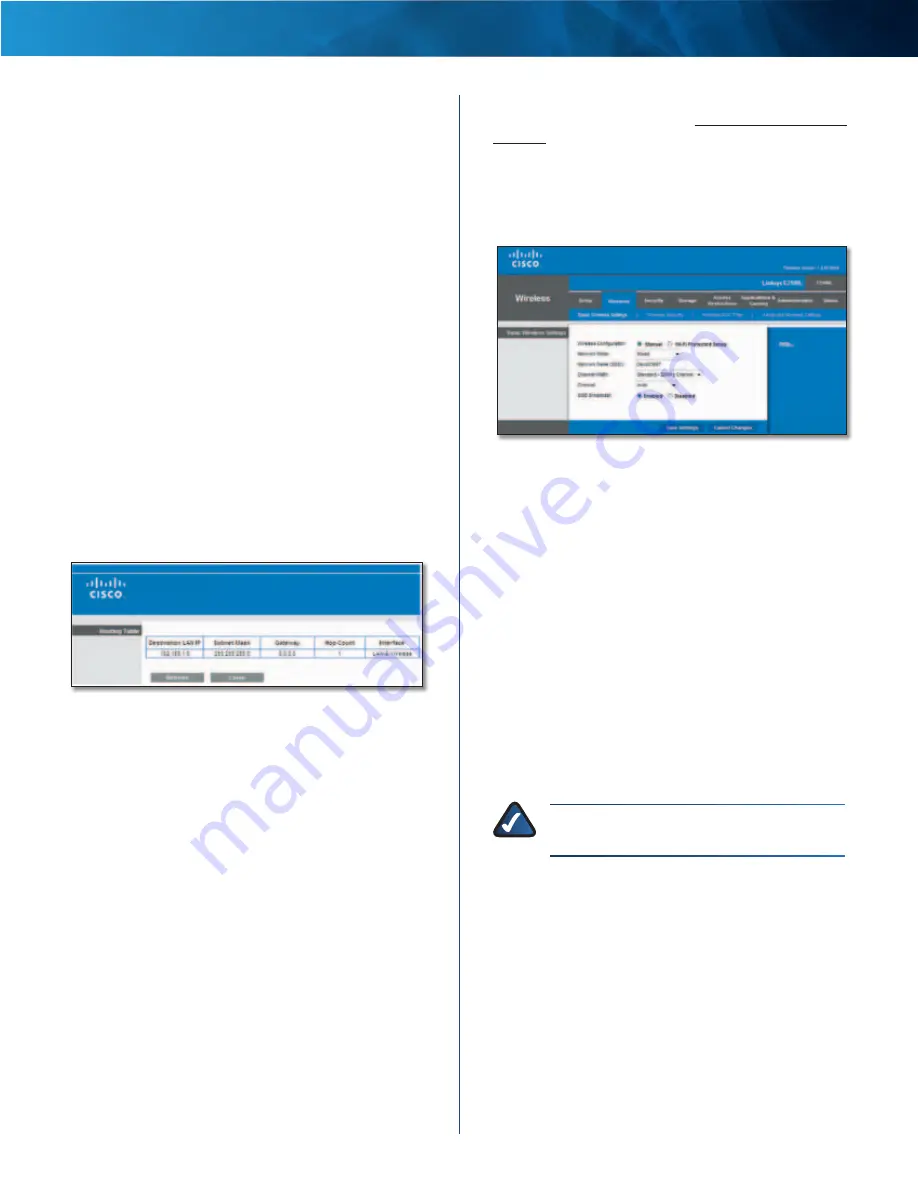
17
Advanced Wireless-N Router
Linksys E2100L
Chapter 3: Advanced Configuration
network . Enter the information described below to set up
a new static route .
Route Entries
To set up a static route between the Router
and another network, select a number from the drop-
down list . Click Delete This Entry to delete a static route .
Enter Route Name
Enter a name for the Route here,
using a maximum of 25 alphanumeric characters .
Destination LAN IP
The Destination LAN (Local Area
Network) IP is the address of the remote network or host
to which you want to assign a static route .
Subnet Mask
The Subnet Mask determines which
portion of a Destination LAN IP address is the network
portion, and which portion is the host portion .
Gateway
This is the IP address of the gateway device that
allows for contact between the Router and the remote
network or host .
Interface
This interface tells you whether the Destination
IP Address is on the LAN & Wireless (Ethernet and wireless
networks) or the Internet (WAN) . (WAN stands for Wide
Area Network .)
Click Show Routing Table to view the static routes you
have already set up .
Advanced Routing > Routing Table
Routing Table
For each route, the Destination LAN IP address,
Subnet Mask, Gateway, Hop Count, and Interface are
displayed . Click Refresh to update the information .
Click Close to exit this screen .
Click Save Settings to apply your changes, or click Cancel
Changes to clear your changes .
Wireless > Basic Wireless Settings
The basic settings for wireless networking are set on this
screen .
There are two ways to configure the Router’s wireless
network(s), manual and Wi-Fi Protected Setup .
Wi-Fi Protected Setup is a feature that makes it easy to set
up your wireless network . If you have client devices, such
as wireless adapters, that support Wi-Fi Protected Setup,
then you can use Wi-Fi Protected Setup .
Wireless Configuration
To manually configure your
wireless networks, select Manual . Proceed to the
Manual
Setup
section . To use Wi-Fi Protected Setup, select Wi-Fi
Protected Setup . Proceed to Wi-Fi Protected Setup,
page 18 .
Manual Setup
If you set the
Wireless Configuration
to Manual, the
Basic
Wireless Settings
screen displays the following fields .
Wireless > Basic Wireless Settings (Manual Setup)
Network Mode
From this drop-down menu, you can
select the wireless standards running on your network .
•
Mixed
If you have Wireless-N, Wireless-G, and
Wireless-B devices in your network, keep the default,
Mixed .
•
BG-Mixed
If you have only Wireless-G and Wireless-B
devices in your network, select BG-Mixed .
•
Wireless-N Only
If you have only Wireless-N devices,
select Wireless-N Only .
•
Wireless-G Only
If you have only Wireless-G devices,
select Wireless-G Only .
•
Wireless-B Only
If you have only Wireless-B devices,
select Wireless-B Only .
•
Disabled
If you do not have any wireless devices in
your network, select Disabled .
NOTE:
If you are not sure which mode to use,
keep the default, Mixed .
Network Name (SSID)
The SSID (Service Set Identifier)
is the network name shared by all devices in a wireless
network . It is case-sensitive and must not exceed
32 keyboard characters . The default is Ciscoxxxxx (xxxxx
are the last five digits of the Router’s serial number) . The
serial number is located on the left side of the product
label, which is on the bottom panel .
Channel Width
The default is Standard - 20 MHz
Channel . For best performance, select Auto to have the
Router automatically select the Channel Width (20 MHz or
40 MHz) .






























